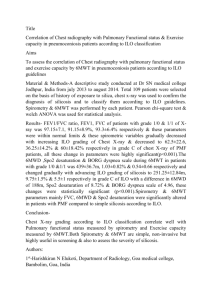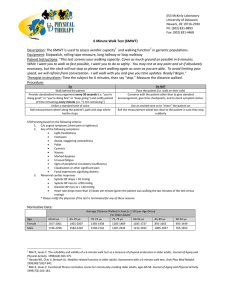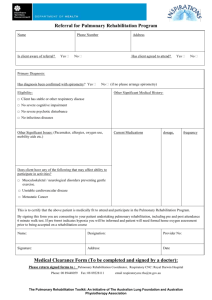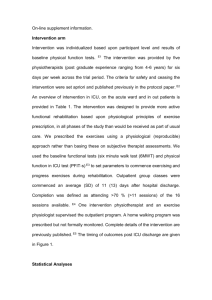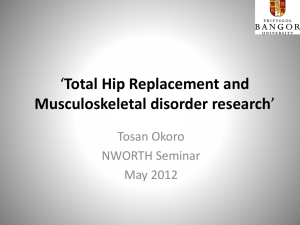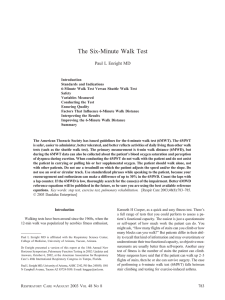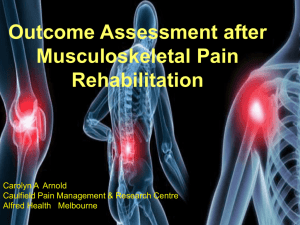Why Six Minutes? - Oxy-View
advertisement
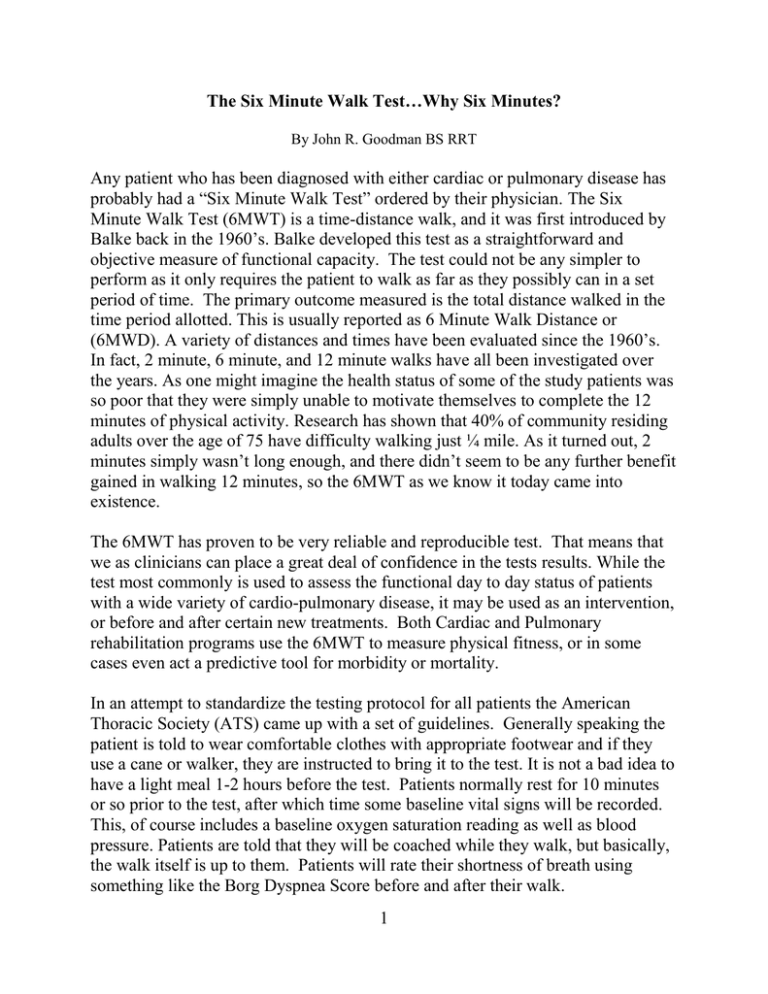
The Six Minute Walk Test…Why Six Minutes? By John R. Goodman BS RRT Any patient who has been diagnosed with either cardiac or pulmonary disease has probably had a “Six Minute Walk Test” ordered by their physician. The Six Minute Walk Test (6MWT) is a time-distance walk, and it was first introduced by Balke back in the 1960’s. Balke developed this test as a straightforward and objective measure of functional capacity. The test could not be any simpler to perform as it only requires the patient to walk as far as they possibly can in a set period of time. The primary outcome measured is the total distance walked in the time period allotted. This is usually reported as 6 Minute Walk Distance or (6MWD). A variety of distances and times have been evaluated since the 1960’s. In fact, 2 minute, 6 minute, and 12 minute walks have all been investigated over the years. As one might imagine the health status of some of the study patients was so poor that they were simply unable to motivate themselves to complete the 12 minutes of physical activity. Research has shown that 40% of community residing adults over the age of 75 have difficulty walking just ¼ mile. As it turned out, 2 minutes simply wasn’t long enough, and there didn’t seem to be any further benefit gained in walking 12 minutes, so the 6MWT as we know it today came into existence. The 6MWT has proven to be very reliable and reproducible test. That means that we as clinicians can place a great deal of confidence in the tests results. While the test most commonly is used to assess the functional day to day status of patients with a wide variety of cardio-pulmonary disease, it may be used as an intervention, or before and after certain new treatments. Both Cardiac and Pulmonary rehabilitation programs use the 6MWT to measure physical fitness, or in some cases even act a predictive tool for morbidity or mortality. In an attempt to standardize the testing protocol for all patients the American Thoracic Society (ATS) came up with a set of guidelines. Generally speaking the patient is told to wear comfortable clothes with appropriate footwear and if they use a cane or walker, they are instructed to bring it to the test. It is not a bad idea to have a light meal 1-2 hours before the test. Patients normally rest for 10 minutes or so prior to the test, after which time some baseline vital signs will be recorded. This, of course includes a baseline oxygen saturation reading as well as blood pressure. Patients are told that they will be coached while they walk, but basically, the walk itself is up to them. Patients will rate their shortness of breath using something like the Borg Dyspnea Score before and after their walk. 1 How many feet can you walk in 6 minutes? How much physical labor? This may be a good time to discuss the physical layout of the “course.” Although the 6MWT has been somewhat standardized, there are differences in testing technique between different clinical centers and labs. In particular, there is not agreement on the length of the test course, the shape of the test course (straight or continuous circle or oval), whether a practice walk should be done before the final test, and whether the best of two or just the second of two walks should be recorded as the “keeper. Walk continuously at your own pace Various measurements will be taken As was anticipated there was a “learning effect” in evidence. On average the second 6MWT showed an increase of 66 feet compared to the first walk. In subsequent studies, it became clear that a circular or oval (continuous) track produced statistically and clinically significant differences in distance walked. In fact, the average was 110 feet. Since we have been doing 6MWTs and its variants for over 50 years to determine a patient’s functional status, the original use of the test that was limited to cardiac and respiratory dysfunction has been substantially widened. Clinical indications now include: pulmonary hypertension, COPD, congestive heart failure (CHF), pulmonary rehabilitation, lung resection, lung transplant, lung volume reduction 2 surgery, interstitial lung disease, cystic fibrosis, peripheral vascular disease, and fibromyalgia. There are just a few contraindications to doing a 6MWT on certain patients. Most of them are common sense and include: unstable angina, resting heart rate over 120/min, recent myocardial infarction, inability to ambulate, and poorly controlled systemic hypertension (Mean Arterial Pressure over 135.) There are also a few other factors that may influence the distance a patient can walk. They include being of short stature, being older than 75, being very tall, being a woman, and of course other significant medical co-morbidities. These could include things like untreated anemia, musculoskeletal limitations, impaired cognition, and interaction with tester. Directions are simple… walk for 6minutes. This is more of a marathon than a sprint. One of the more important variables that needs to be considered includes the relationship between the patient and the technician who is testing them. To avoid having the patient try and “track” their tester, it is recommended that the technician walk behind the patient so it is the patient that sets the pace. The technician may carry the patient’s oxygen if necessary. If the patient needs to adjust their oxygen flow rate, this must be noted by the technician as well as the saturation achieved. Encouragement phrases such as “you are doing well,” and “keep up the good work” can be called out at regular intervals. To assist the patient with their pacing, it is common to announce elapsed time at the halfway point, with 2 minutes remaining, and then when there is one minute remaining. Chairs are normally placed along the route so that a patient may sit to catch their breath should that be necessary. Now that the patient has completed their full 6MWT they should immediately rate their dyspnea using the Borg scale once again. Other questionnaires can be administered to rate the patients activities of daily living (ADL). Physical activity levels can also be assessed by simple questionnaire, as well as quality of life assessments. At this point one can see why the 6MWT is most commonly 3 performed in a cardiac or pulmonary rehabilitation setting. All of the necessary equipment, plus enough physical space to lay out the course, the availability of trained staff and an emergency cart are all centrally located. Reports can be generated and delivered almost in real time to the referring physician. Results of the 6MWT have compared very favorably to the same tests performed on a treadmill. The beauty of the 6MWT is its utter simplicity. There is almost no specialized equipment required beyond that which is normally found in a clinical setting. The test is also very inexpensive to perform (estimated at $150.00). Many studies have been done over the years to give us normal values for the 6MWT. Looking at the results of 10 different studies we find (for men) the actual distance walked varies widely from a low of 399 meters to a high of 778 meters. The mean value for men was 576 meters in 6 minutes. For women the range was 310 meters to 664 meters with a mean distance of 494 meters walked in 6 minutes. As expected, the distance walked in 6 minutes goes down as we age. There is a pretty strong correlation with how well we do on the test and our own self-reported functional ability. The 6MWT has a very high index of reproducibility, takes very little staff time, and perhaps most important of all, does NOT require a physician to be in attendance. All in all, we get a great deal of information from this economical, simple, and safe way to check our patients functional status. 4
